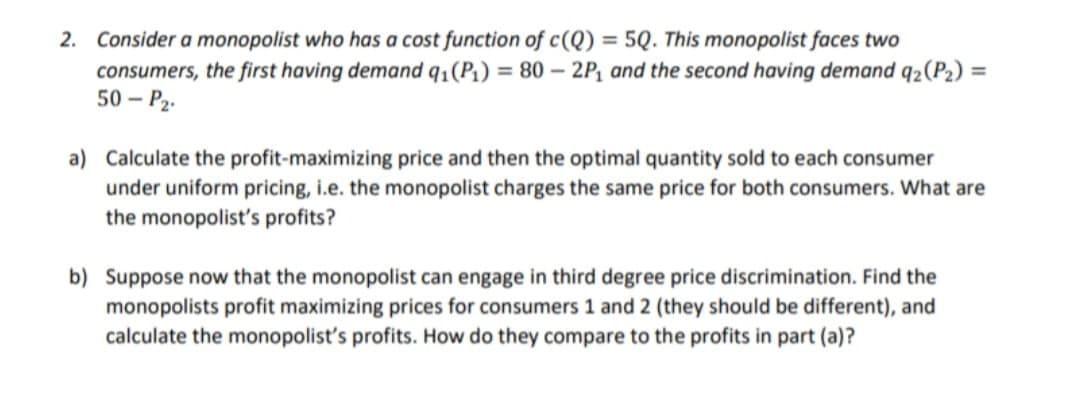2. Consider a monopolist who has a cost function of c(Q) = 5Q. This monopolist faces two consumers, the first having demand q₁(P₁) = 80 - 2P₁ and the second having demand q₂(P₂) = 50-P₂- a) Calculate the profit-maximizing price and then the optimal quantity sold to each consumer under uniform pricing, i.e. the monopolist charges the same price for both consumers. What are the monopolist's profits? b) Suppose now that the monopolist can engage in third degree price discrimination. Find the monopolists profit maximizing prices for consumers 1 and 2 (they should be different), and calculate the monopolist's profits. How do they compare to the profits in part (a)?
2. Consider a monopolist who has a cost function of c(Q) = 5Q. This monopolist faces two consumers, the first having demand q₁(P₁) = 80 - 2P₁ and the second having demand q₂(P₂) = 50-P₂- a) Calculate the profit-maximizing price and then the optimal quantity sold to each consumer under uniform pricing, i.e. the monopolist charges the same price for both consumers. What are the monopolist's profits? b) Suppose now that the monopolist can engage in third degree price discrimination. Find the monopolists profit maximizing prices for consumers 1 and 2 (they should be different), and calculate the monopolist's profits. How do they compare to the profits in part (a)?
Chapter14: Monopoly
Section: Chapter Questions
Problem 14.5P
Related questions
Question
Solve Only part a .......

Transcribed Image Text:2. Consider a monopolist who has a cost function of c(Q) = 5Q. This monopolist faces two
consumers, the first having demand q₁(P₁) = 80 - 2P₁ and the second having demand q₂(P₂) =
50-P₂-
a) Calculate the profit-maximizing price and then the optimal quantity sold to each consumer
under uniform pricing, i.e. the monopolist charges the same price for both consumers. What are
the monopolist's profits?
b) Suppose now that the monopolist can engage in third degree price discrimination. Find the
monopolists profit maximizing prices for consumers 1 and 2 (they should be different), and
calculate the monopolist's profits. How do they compare to the profits in part (a)?
Expert Solution
This question has been solved!
Explore an expertly crafted, step-by-step solution for a thorough understanding of key concepts.
Step by step
Solved in 3 steps

Knowledge Booster
Learn more about
Need a deep-dive on the concept behind this application? Look no further. Learn more about this topic, economics and related others by exploring similar questions and additional content below.Recommended textbooks for you









Managerial Economics: Applications, Strategies an…
Economics
ISBN:
9781305506381
Author:
James R. McGuigan, R. Charles Moyer, Frederick H.deB. Harris
Publisher:
Cengage Learning